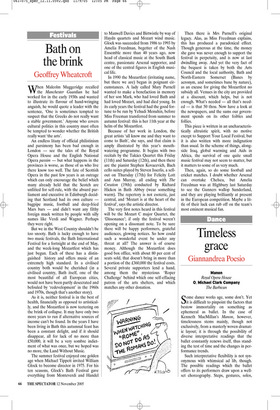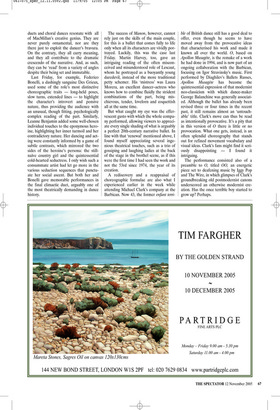Timeless grace
Giannandrea Poesio
Manon Royal Opera House O, Michael Clark Company The Barbican Some dance works age, some don’t. Yet it is difficult to pinpoint the factors that bestow immortality on something as ephemeral as ballet. In the case of Kenneth MacMillan’s Manon, however, timelessness stems mainly, though not exclusively, from a masterly woven dramatic layout; it is through the possibility of diverse interpretative readings that the ballet constantly renews itself, thus standing the test of time and the changes in performance trends.
Such interpretative flexibility is not synonymous with whimsical ad lib, though. The possible readings which the ballet offers to its performers draw upon a wellset choreography. Steps, gestures, solos, duets and choral dances resonate with all of MacMillan’s creative genius. They are never purely ornamental, nor are they there just to exploit the dancer’s bravura. On the contrary, they all carry meaning, and they all contribute to the dramatic crescendo of the narrative. And, as such, they can be ‘read’ from a variety of angles despite their being set and immutable.
Last Friday, for example, Federico Bonelli, a dashingly sanguine Des Grieux, used some of the role’s most distinctive choreographic traits — long-held poses, slow turns, extended lines — to highlight the character’s introvert and pensive nature, thus providing the audience with an unusual, though fitting, psychologically complex reading of the part. Similarly, Leanne Benjamin added some well-chosen individual touches to the eponymous heroine, highlighting her inner turmoil and her contradictory nature. Her dancing and acting were constantly informed by a game of subtle contrasts, which mirrored the two sides of the heroine’s persona: the stillnaïve country girl and the quintessential cold-hearted seductress. I only wish such a consummate artist had let go more in the various seduction sequences that punctuate her social ascent. But both her and Bonelli gave memorable performances in the final climactic duet, arguably one of the most theatrically demanding in dance history. The success of Manon, however, cannot rely just on the skills of the main couple, for this is a ballet that comes fully to life only when all its characters are vividly portrayed. Luckily, this was the case last Friday. Martin Harvey, too, gave an intriguing reading of the often misconceived and misunderstood role of Lescaut, whom he portrayed as a buoyantly young daredevil, instead of the more traditional petty schemer. His ‘mistress’ was Laura Morera, an excellent dancer–actress who knows how to combine fluidly the strident combinations of the part, being mischievous, tender, lovelorn and coquettish all at the same time.
But what caught my eye was the effervescent gusto with which the whole company performed, allowing viewers to appreciate every single shading of what is arguably a perfect 20th-century narrative ballet. In line with that ‘renewal’ mentioned above, I found myself appreciating several ingenious theatrical touches, such as a trio of gossiping and laughing ladies at the back of the stage in the brothel scene, as if this were the first time I had seen the work and not the 53rd since 1974, the year of its creation.
A rediscovery and a reappraisal of choreographic formulae are also what I experienced earlier in the week while attending Michael Clark’s company at the Barbican. Now 43, the former enfant terri ble of British dance still has a good deal to offer, even though he seems to have moved away from the provocative ideas that characterised his work and made it known all over the world. O, based on Apollon Musagète, is the remake of a work he had done in 1994, and is now part of an ongoing collaboration with the Barbican, focusing on Igor Stravinsky’s music. First performed by Diaghilev’s Ballets Russes, Apollon Musagète has become the quintessential expression of that modernist neo-classicism with which dance-maker George Balanchine was generally associated. Although the ballet has already been revised three or four times in the recent past, it still remains almost an ‘untouchable’ title. Clark’s move can thus be read as intentionally provocative. It’s a pity that in this version of O there is little or no provocation. What one gets, instead, is an often splendid choreography that stands out for refined movement vocabulary and visual ideas. Clark’s fans might find it seriously disappointing — I found it intriguing.
The performance consisted also of a preamble to O, titled OO, an energetic piece set to deafening music by Iggy Pop and The Wire, in which glimpses of Clark’s groundbreaking old postmodernist canons underscored an otherwise modernist creation. Has the once terrible boy started to grow up? Perhaps.




























































 Previous page
Previous page